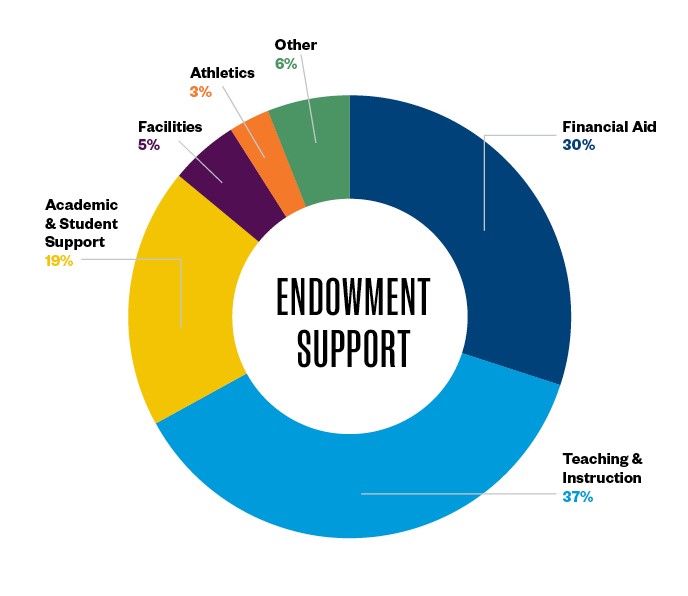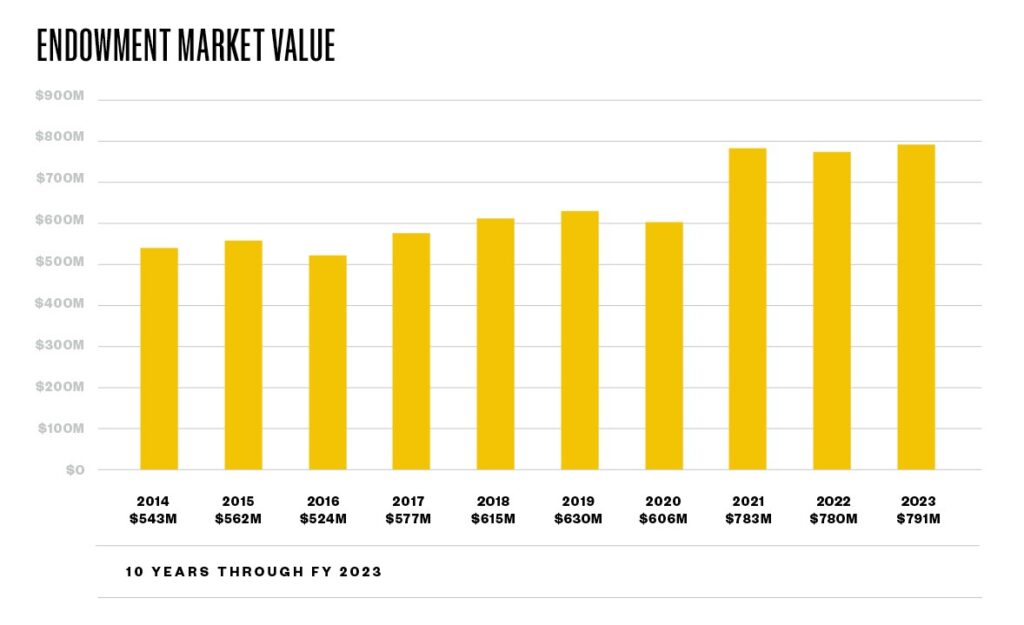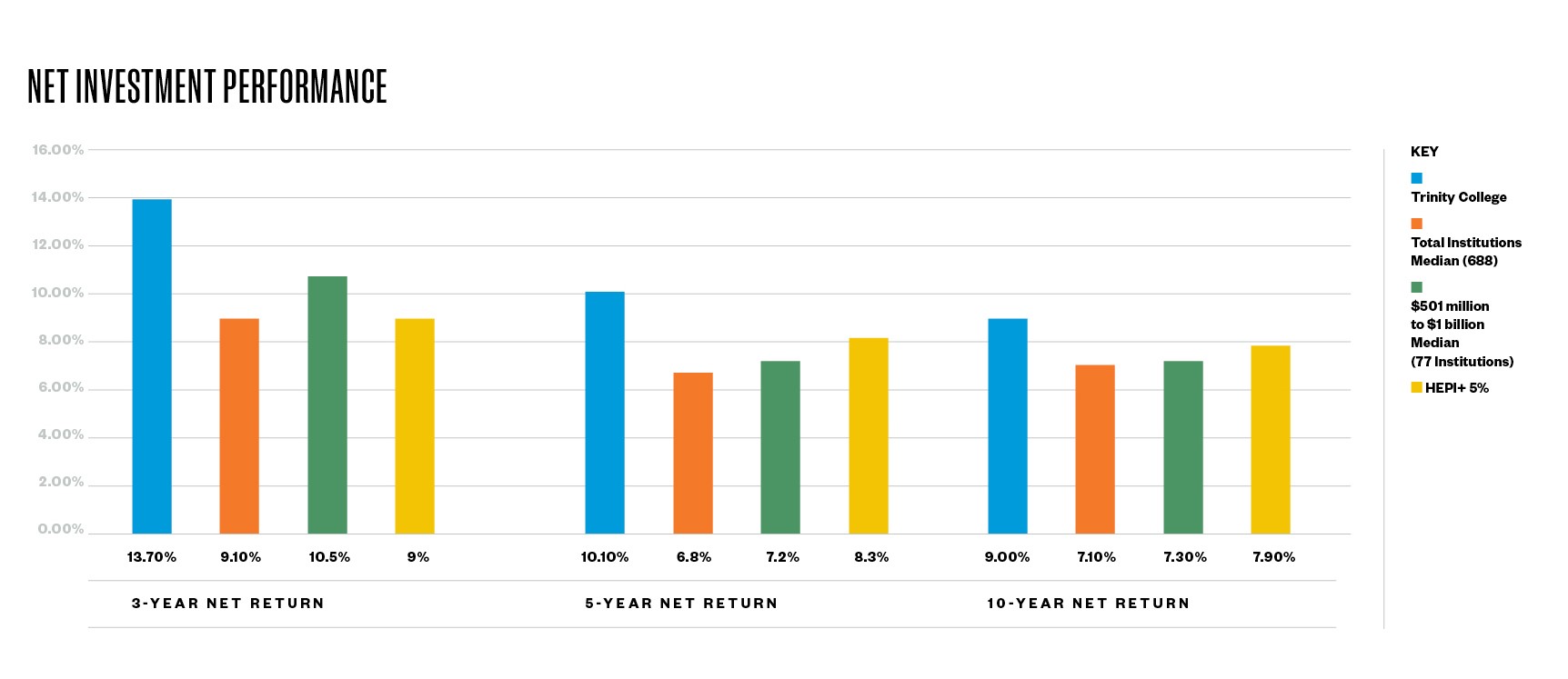Trinity’s Endowment
Financial strength for the long term
Increasing Trinity’s endowment is a key goal of the All In comprehensive campaign. But what exactly is an endowment? How does it differ from the Trinity College Fund and other avenues of giving? The Trinity Reporter asked these questions and more of alumnus Tim Yates ’94, of Commonfund, which manages the College’s endowment. Read on to learn more.
What is an endowment?
When people talk about a college’s endowment, they often envision a single pool of money, like a bank account, which a college may use for any purpose. In reality, colleges don’t have a single endowment and aren’t free to use endowed funds as they like. Rather a college’s endowment is most typically composed of hundreds, if not thousands, of individual endowments or gifts that usually are restricted for a particular purpose by the donor, such as for financial aid, and intended to provide financial support in perpetuity. In the case of Trinity College, the endowment is made up of more than 1,000 individual endowments that provide critical support to the College.

What is the purpose of an endowment?
For most colleges, the cost of educating its students is not fully covered by the net tuition revenue they receive from those enrolled. As such, colleges rely on the generosity of their donors to supplement tuition revenue. This support comes in two general forms: annual or current gifts, which provide funds for current fiscal year support, and endowment gifts, which are intended to provide support forever. An endowment’s purpose is to support the institution this fiscal year and every fiscal year for generations to come. At Trinity, we consider the overarching objective of the endowment to be maintaining “intergenerational equity,” or preserving the purchasing power of the endowment, in real terms or adjusted for inflation, across all generations of Bantams.
What is the difference between annual Trinity College Fund gifts and endowment gifts?
Let’s start by acknowledging that both forms of charitable activity are mission-critical and are essential to providing excellence across the student experience. Let’s also recognize that most successful higher ed institutions maximize both. That said, some simple math will help illustrate the difference between current gifts and endowment gifts. Imagine a generous donor has $1 million to give to the College. If given to the College as an annual gift, the $1 million will be used, usually at the discretion of the College, on all the important areas of need in a given fiscal year. In contrast, if given to the College as an endowed gift, the $1 million will be invested and a portion of earnings from the gift, normally between 4 and 5 percent of the market value of that gift, will be used every fiscal year in perpetuity. As discussed, the use of these endowed funds usually is designated by the donor.
How much has been added to the endowment through the All In campaign?
Since the All In campaign started in 2016, $93.7 million has been committed in endowment gifts supporting financial aid, academic programs, and student life activities. During the campaign, alumni and parents also have put Trinity in their estate plans for a total of $84.8 million, some of which eventually will be added to the endowment.

How big is Trinity’s endowment?
As of June 30, 2023, Trinity’s endowment stood at $791 million. During President Joanne Berger-Sweeney’s tenure, the endowment has grown at a compounded annual growth rate (CAGR) of 3 percent, rising from $543 million in 2013 to today’s value. This growth has come from a combination of investment returns and contributions/gifts to the endowment. Importantly, this growth has come on top of the annual spending or withdrawals that are taken out to fund the operating budget and other purposes.
The nominal value of the endowment is an interesting—but only one—measure of Trinity’s financial strength. Two other important measures are endowment per student and how much of the College’s operating budget is supported by the draw, or spending, from the endowment. In the case of the former, Trinity has roughly $347,000 of endowment wealth per student, and, in the case of the latter, 21 percent of the College’s total operating budget is supported by the roughly $35 million annual endowment spend.
How is Trinity’s endowment managed?
Trinity College’s Board of Trustees has designated a subcommittee of the board to oversee the management of the endowment. The Investment Subcommittee is composed of a group of highly talented professionals who volunteer their time and talent. They are tasked with shouldering the fiduciary duty in ensuring the endowment is managed in a way that continually grows and improves its ability to support the College in perpetuity. The Investment Subcommittee has outsourced the day-to-day management of the endowment to Commonfund, a Connecticut-based nonprofit investment firm that has been managing college endowments for more than 50 years. Working with the Commonfund team that I lead, the Investment Subcommittee sets the long-term strategic policies for the endowment, including a target asset allocation. Commonfund then uses its resources to select independent, third-party investment managers who are experts in particular asset classes and strategies to implement the policy asset allocation.
Trinity College Investment Subcommittee
Chair: James Yu ’87, Partner, EQT Services LTD
Peter Blum ’72, P’12, Managing Partner, Colrain Capital
Malcolm MacLean ’92, Managing Partner, Star Asia Group
Henry Mallari-D’Auria ’83, Chief Investment Officer, Ariel Investments
Kevin Maloney ’79, Chair, Department of Finance, Bryant University
David Schnadig ’86, Co-president, Cortec Group
Douglas Tansill ’61, Trustee Emeritus
Jean Walshe ’83, Managing Director, J.P. Morgan Asset Management
Lisa Bisaccia ’78, Board Chair, ex officio
Joanne Berger-Sweeney, President, ex officio
Craig Vought ’82, P’17 Managing Director and Co-founder, Broadreach Capital Partners, ex officio
How has the endowment performed?
Trinity’s endowment has performed very well, with its long-term return placing it well into the upper quartile of all college and universities. As of June 30, 2023, Trinity’s 10-year net return of 9 percent outperformed the long-term investment objective of inflation plus spending, as measured by the HEPI +5 percent, by 1.1 percent and the median college endowment by 1 percent. (HEPI—the Higher Education Price Index—is an inflation index designed to track the main cost drivers of colleges and universities in the United States.)
Source: 2023 NACUBO-Commonfund Study of Endowments. The NACUBO-Commonfund Study of Endowments (NCSE) is an analysis of financial, investment, and governance policies at endowed institutions of higher learning. All rights reserved. For fiscal year 2023, 688 institutions representing $839 billion in endowment assets participated. For additional information on the NCSE, please go to https://www.nacubo.org/Research/2023/NACUBO-Commonfund-Study-of-Endowments.

How can alumni and friends of the College get involved?
For more information on the All In campaign and how you can contribute to Trinity’s endowment and other fundraising priorities, please contact Caitlin Gasiorski at [email protected].
Watch President Berger-Sweeney talk about the importance of the role of the endowment.
More on Tim Yates ’94
Timothy T. Yates Jr. ’94, president and CEO of Commonfund OCIO, leads a team of professionals who advise, implement, and monitor custom investment solutions for nonprofit institutions with total assets under management of more than $15 billion. After graduating from Trinity with a B.A. in modern languages, he earned an M.B.A. in finance with a designation in international business from Fordham University. Yates also has served on Trinity’s Board of Fellows.
Header photo by Nick Caito: Tim Yates ’94, second from right, meets with Pedro Mateo ’25, Kylie Taylor ’24, and Nicole Balbuena Gutierrez ’26.
